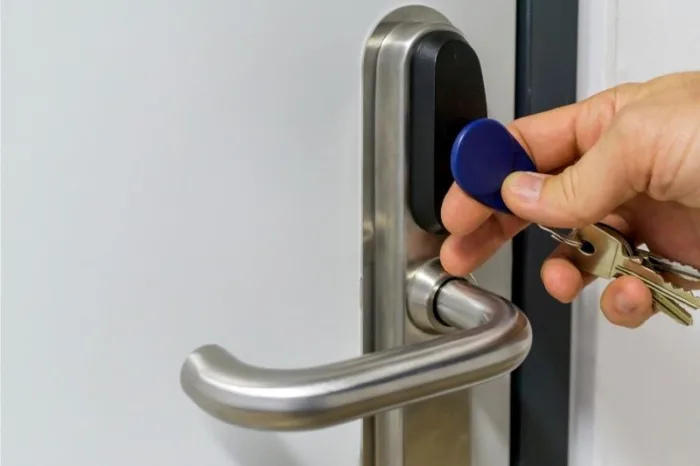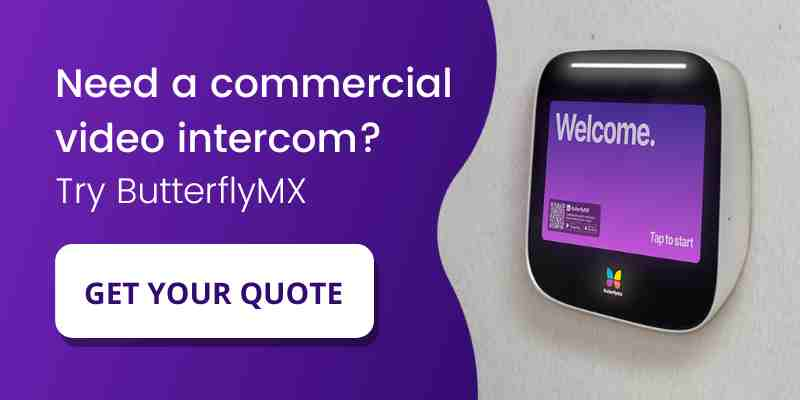Key takeaways:
- Commercial key fob door lock systems are commonly used in office buildings. They’re also commercially graded for durability, security, materials, quality, and functionality.
- Commercial key fobs are beneficial because they are easy to use and don’t require WiFi connectivity. Conversely, their disadvantages are that they aren’t much better than regular keys and have no additional security features or guest access.
- Commercial key fobs can still be effectively used in your building because the locks are highly graded. As a result, they’re best used for staff-only areas.
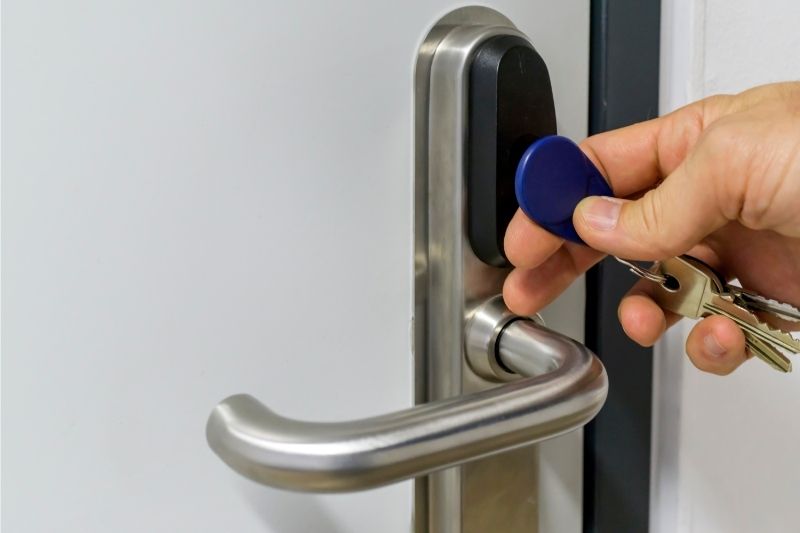
Controlling access in your building can be a struggle. You want something tenants can easily use without compromising your property’s security. One good option is commercial key fob door lock systems, which are one of the easiest commercial door locks to use. However, when it comes to their usefulness as the primary access control system for your building, there’s a lot to learn.
Every building has unique needs, and different systems will suit different buildings. This guide covers what a key fob door lock system is and how it works. Next, we go over the different commercial door lock types. By the end of this guide, you’ll know whether a key fob door entry system is right for your building.
This post covers:
- What are commercial key fob door lock systems?
- How do commercial key fob door lock systems work?
- Pros and cons of commercial key fob door lock systems
- Alternatives to a commercial key fob door lock system
What are commercial key fob door lock systems?
A commercial key fob door lock system is a lock that can be opened with a key fob access credential. The key fob can either be a handheld remote control device with buttons or a scannable device with RFID tags.
But: What is a key fob system?
A key fob system for buildings is a form of electronic access control. It requires distributing key fob devices to tenants, who scan them to open doors. These systems work similarly to key card door locks—the only difference is that tenants use fobs instead of cards.
Components of a key fob door lock system include:
- Access reader that scans the key fob.
- Access credentials in the form of key fobs, which are electronic devices with a built-in sensor or chip that scans with the access reader.
- RFID door lock that secures the door in a locked state. It uses electromagnetic fields to communicate with the access reader. The lock is released by the access reader when the proper credentials are scanned.
In offices and industrial properties, commercial systems can be installed at:
- Utility rooms
- Management-only areas
- Office suites
- Amenity spaces
- Restrooms
- Rooftop access points
- Maintenance areas
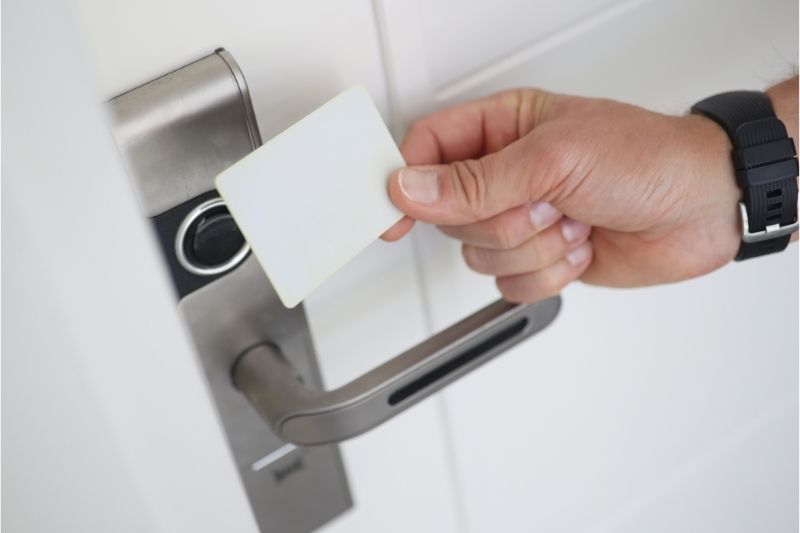
How do commercial key fob door lock systems work?
A key fob door lock system works by electric or magnetic locking mechanisms to lock the door.
More specifically, the system activates by:
- A tenant scans their key fob device at the access reader on the door.
- Next, the reader assesses the fob’s credential using RFID (radio frequency identification) technology.
- Finally, if a valid credential is scanned, the access reader signals the electronic door lock to release, allowing the tenant to enter.
Watch how ButterflyMX works:
How are commercial door locks different?
Commercial door lock systems are different from other locks because they’re made for industrial use. They are commonly found in office buildings, warehouses, hospitals, and other commercial real estate developments. A commercial-grade lock is the highest quality lock available. It’s meant for enhanced security and is finely crafted to be more durable than lower-quality locks.
How much does a commercial key fob lock cost?
A commercial key fob lock system costs between $1,300 and $2,000, not including installation. Additionally, key fobs can range between $50 and $400 to replace. Depending on how many tenants are in your building, you’ll need to factor in the cost of at least one key fob for each unit into your budget.
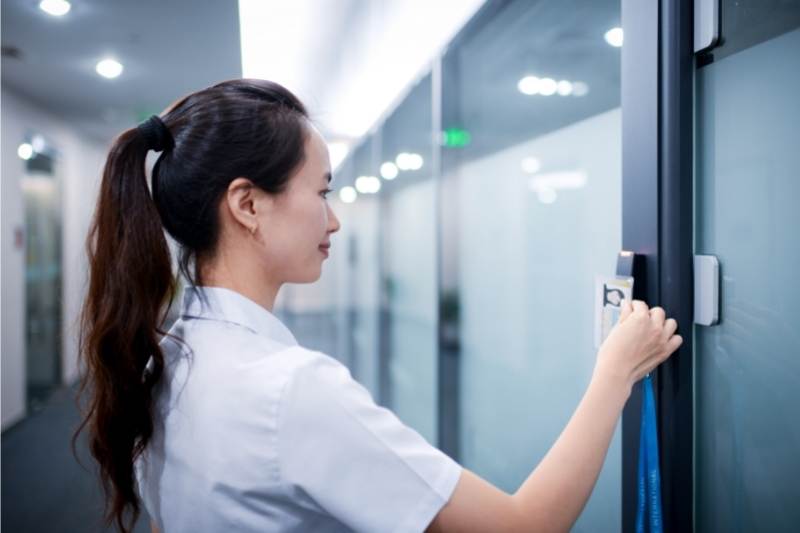
Pros and cons of commercial key fob door lock systems
Before purchasing commercial key fob door locks for your building or recommending them to a client, first consider their advantages and disadvantages.
Ultimately, commercial key fobs are only a slight improvement over old-school locks that require brass keys. Their main benefits are that they will quickly open a door instead of awkwardly fitting a key into a keyhole.
With that said, key fob door lock systems can still be used effectively in your building. For instance, in restrictive, staff-only areas, these door locks are efficient at securing an area that only someone with the correct key fob or key card can access.
Alternative commercial key fob door lock systems
- Commercial keypad door locks: This is a commercial lock secured by a numerical or touchscreen-based keypad.
- Smart locks: This is an electronic lock that can be remotely activated by a smartphone. Most commercial smart locks pair with a mobile app.
- Keypad access control devices: These are standalone devices separate from your door lock. You install them near the door where you want to control access. Some keypads also pair with a mobile app to offer smartphone-based access.
Watch how ButterflyMX keypads work:
ButterflyMX Keypads
When it comes to controlling both tenant and visitor access at large commercial properties, the ButterflyMX Keypad is the best alternative to key fob door lock systems. The Keypad is a modern, smartphone-powered system that facilitates seamless door entry.
Benefits of the ButterflyMX Keypad include:
- Guest access. Tenants can remotely give visitors access via a temporary PIN code.
- Easy installation. The ButterflyMX Keypad connects to an existing electronic door strike.
- Security camera. Each time someone uses the Keypad, their picture is taken and their user information is logged. This ensures building and tenant safety.
- Automatic updates. The Keypad automatically downloads and installs software updates through the internet. Additionally, it troubleshoots bugs and software issues automatically.
- Cloud-based technology. All tenant information and door entry logs are stored in the cloud.
- Smartphone connectivity. Tenants can connect their smartphones to the Keypad and enter by swiping their phone screens. They can also grant guests access right from their phones.
